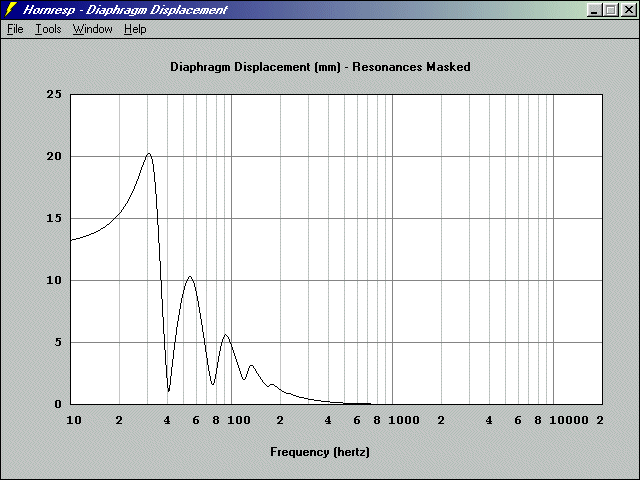

Posted by Wayne Parham [ 66.139.38.192 ] on September 16, 2005 at 01:26:02:
In Reply to: Re: Just because I'm in the mood to argue ... posted by manualblock on September 15, 2005 at 19:33:16:
Here's another way of looking at it. The excursion chart shown below is of a very large basshorn, one that is tuned to operate above 30Hz and that has plenty of mouth area to provide good response without ripples in halfspace, even if only one horn is used. In short, it's a no compromise design. It is also huge, about 40 cubic feet.

Notice how overall excursion is reduced by the horn, but also how there are excursion peaks throughout the passband, with the maximum being right at horn cutoff. This particular horn uses drivers that have fairly long throw, so they aren't at their mechanical limits even at the peak. But still, you see the general trend.
Now imagine if the horn were made as small as possible. Path area must be made small, so response is now compromised, being a series of deep ripples. Corner loading really helps in this regard. In fact, you probably would consider corner loading a requirement of such a device. Even so, the low frequency cutoff must be made higher, because there just isn't enough room inside the box to support a long path length. That means the excursion peak is shifted up, well into the passband. As you can see, the biggest requirement is that the woofer have good excursion capability. The horn just isn't able to load the driver down low.
Don't misunderstand me. I think Gar's horn is probably good down to about 50Hz. When corner loaded, it might be just fine to augment say a single driver speaker or something that needs help below 100Hz. It could extend bass an octave below that. But if its application is to be used under 60Hz, it's being used primarily in the range where it is a direct radiator anyway. So it makes some sense to use a cabinet that is better suited for that frequency range, using the volume to make an alignment that works well to 20Hz. With 3ft3, that suggests a vented box tuned to 20Hz and a driver that can support it.
Using a woofer with limited displacement just doesn't make sense in a sub, horn loaded or not. I'd rather have a direct radiator with some surface area and excursion than a physically small basshorn with a smaller driver. It will just plain run out of gas. The one possible exception is ultra-low power systems that won't see more than a watt or two.
So my conclusion is this: If you want to make a basshorn sub, make it big or don't make it at all. A midbass horn can be made smaller. Other cabinet styles can be made smaller too. But basshorn subs need size. There's no substitute for cubic inches.
[ Craftsmen Forum ] [ Help ]